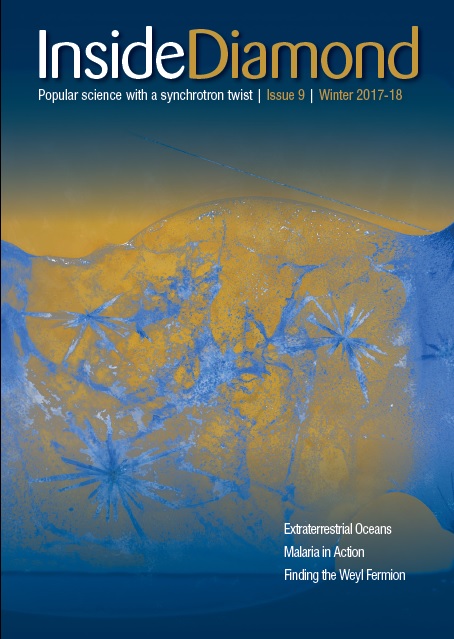Keep up to date with the latest research and developments from Diamond. Sign up for news on our scientific output, facility updates and plans for the future.
These articles were published in our popular science magazine: Inside Diamond

Those articles were published in our popular science magazine: Inside Diamond
Latest edition:
This article was recently published in our popular science magazine: Inside Diamond

Polio is a particularly nasty disease. Highly infectious, it mostly hits children under five and can lead to permanent paralysis and death. Efforts to control polio represent one of the huge successes of modern medicine.
.2020-02-21-14-30-25.png)
3D images showing the surface of the outer shell of the synthetic polio vaccine.
Credit: University of Oxford and Diamond Light Source, eBIC.
A worldwide vaccination campaign has dramatically reduced the number of cases from around 350,000 in 1988 to 37 reported in 2016, according to the World Health Organisation. It has almost been eradicated. Almost. It still lingers in a few places, and as long as it does, it has the potential to spread through the world’s children once again. Now, a new type of vaccine has been developed that has the potential to see off this disease for good.
Developed by a UK wide team led by Dave Rowlands at Leeds University and made in plants by the team of George Lomonossoff at the John Innes Centre, Diamond played a crucial role in demonstrating that it really does do what the researchers hoped. The most effective current polio vaccine is based on a weakened form of the virus and is given as oral drops. Easy and painless. However, this vaccine has a number of potentially serious drawbacks. It is made from active polio virus so needs a constant supply of this dangerous pathogen. It occasionally reverts to an active form of the disease as it passes through the vaccinated child and has caused disease this way. It also needs to be kept refrigerated making it tricky to transport to the world’s most inaccessible areas which are, typically, the places it is needed most.
Researchers set out to eradicate this disease forever.
The polio virus is a simple icosahedron made of protein building blocks. The scientists started by putting genes from a mutant form of polio into tobacco plants. The basic technique has been around for decades and was successfully used in a similar way to produce a foot and mouth vaccine in insect cells. As they hoped, these genes persuaded the tobacco plants to produce proteins in their leaves, which then formed into synthetic virus-like particles.
According to Dave Stuart, Professor of Structural Biology at Oxford University and Director of Life Sciences at Diamond, “it’s not a virus, it’s a pretend version of the virus, it’s completely safe because it doesn’t have the genetic information, it can’t replicate.” But it is designed to trigger an immune response to protect against disease. The next step was to see whether these synthetic particles really did look like the real virus, and this is where Diamond enters the picture. The technique they used was cryo-electron microscopy at the electron Bio-Imaging Centre or eBIC. Frozen samples were imaged in an electron microscope to produce very detailed, highly magnified pictures of the particles which turned out to look just like the real thing.
Then the scientists subjected their particles to a whole series of tests. They turned out to be stable at room temperature so did not need refrigerating. They cannot revert to an active form of the disease like the current vaccine. And finally, growing it in tobacco plants removes the need to produce the active polio virus. This new synthetic vaccine manages to overcome the disadvantages of the current vaccines. Human trials are the next step but as always with science, a note of caution is needed. This is a proof of principle and there is some way to go before it could become a working vaccine.
Diamond Light Source is the UK's national synchrotron science facility, located at the Harwell Science and Innovation Campus in Oxfordshire.
Copyright © 2022 Diamond Light Source
Diamond Light Source Ltd
Diamond House
Harwell Science & Innovation Campus
Didcot
Oxfordshire
OX11 0DE
Diamond Light Source® and the Diamond logo are registered trademarks of Diamond Light Source Ltd
Registered in England and Wales at Diamond House, Harwell Science and Innovation Campus, Didcot, Oxfordshire, OX11 0DE, United Kingdom. Company number: 4375679. VAT number: 287 461 957. Economic Operators Registration and Identification (EORI) number: GB287461957003.